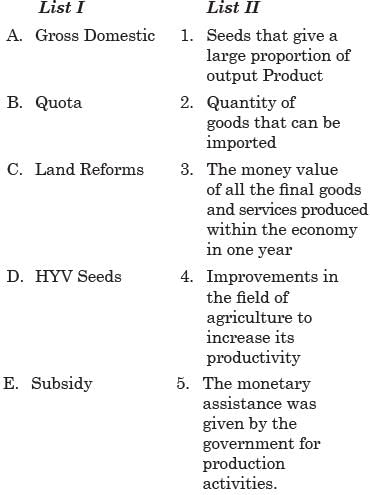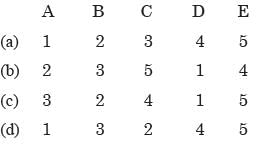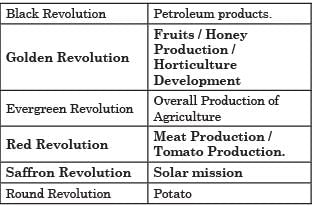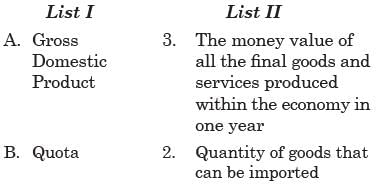Test: Economy NCERT Based Test - 1 - UPSC MCQ
25 Questions MCQ Test - Test: Economy NCERT Based Test - 1
Which of the following is/are correct regarding the Drain of Indian Wealth?
1. India’s foreign trade during colonial period focused on export surplus generation.
2. The export surplus was used for the welfare of Indian economy.
Select the correct answer using the code given below:
1. India’s foreign trade during colonial period focused on export surplus generation.
2. The export surplus was used for the welfare of Indian economy.
| 1 Crore+ students have signed up on EduRev. Have you? Download the App |
Match the following:


Select the correct answer using the code given below:

When the RBI announces an increase of the Cash Reserve Ratio (CRR), what does it mean?
‘Golden Revolution’, often seen in the news, is related to:
If the RBI adopts an expansionist open market operations policy, this means that it will:
Consider the following statements
1) Primary Deficit cannot be higher than Fiscal Deficit.
2) Primary Deficit is obtained by deducting interest rates from Revenue Deficit.
3) Fiscal Deficit cannot be lower than budget deficit.
Which of the above statement(s) is/are NOT correct ?
Which of the following are the possible consequences of the Revenue Deficit?
1. Dissaving by the government.
2. The government borrows to finance its investment and consumption requirements.
3. It leads to lower growth and adverse welfare implications.
4. A higher revenue deficit creates a higher repayment burden on government.
Select the correct answer using the code given below:
Anti-Dumping duties includes the feature:
1) It is a duty which is imposed by way of additional imports duty on goods.
2) Sometimes as the cost of the goods is even below the cost of production in the country of origin.
Which of these statements is/are correct ?
Departments under the Ministry of Finance includes :
1) Economics Affairs
2) Expenditure
3) Disinvestment
Choose the correct one:
Consider the following statements regarding the privatization of the public sectors:
1. Privatization of the public sector enterprises (PSEs) by selling off part of the equity of them is known as disinvestment.
2. The purpose of the privatization is mainly to improve financial discipline and facilitate modernization.
Which of the above statements is/are correct?
Which of the following are components of ‘revenue expenditure’
1) Interest payments on banks
2) Salaries and pensions of government expenses
3) Subsidies
4) Grants to foreign countries
5) Loans to Indian states.
Select the correct answers using the codes given below:
Match the following:

Select the correct answer using the code given below:

With reference to the Green Revolution, consider the following statements:
1. The first phase of this revolution benefited wheat and rice-growing regions only.
2. The Green Revolution implemented to make India a self-sufficient country in context of food grain.
3. It adopted modern methods and technology in Indian agriculture.
Which of the above statements is/are correct?
Which of the following statements is/are incorrect regarding the term “health”?
1. It is not only an absence of disease but also the ability to realize one’s potential.
2. It is assessed by using life expectancy indicators only.
Select the correct answer using the code given below:
Consider the following statements regarding Agricultural Marketing:
1. It is a process that involves the selling of agricultural commodities in the market.
2. Regulated market, provision of physical infrastructure and policy instruments like minimum support price (MSP) are some measures taken by the government to improve it.
3. The regulated market aims at the elimination of unhealthy and unscrupulous practices, reducing market costs and providing benefi ts to both producers as well as the sellers in the market.
Which of the above statements is/are correct?
Which of the following best describes the ‘Liberty Indicators’ in the context of Human Development?
Which of the following statements are correct regarding the objectives of land reforms in India at the time of independence?
1. To bring tenants under the direct control of the government.
2. To abolish intermediaries.
3. To shift ownership of land to the tenants.
Select the correct answer using the code given below:
Consider the following statements regarding the Demographic Transition Theory:
1. It is a theory that throws light on changes in birth rate and death rate and consequently on the growth rate of the population.
2. Population explosion implies that the death rate is decreasing while birth rate is increasing.
Which of the above statements is/are correct?
Consider the following statements regarding the Great Leap Forward campaign:
1. It initiated in China in 1958.
2. It aimed at industrialising the country.
Which of the above statements is/are correct?























